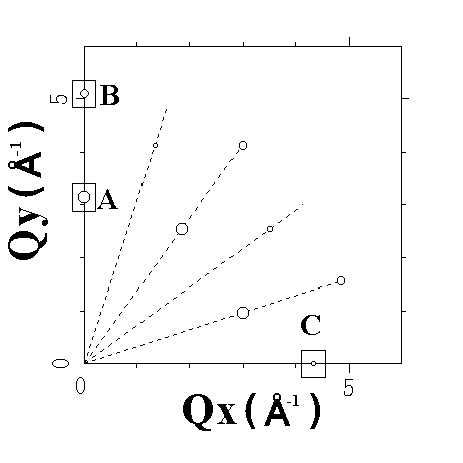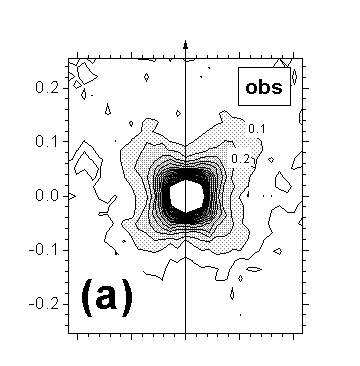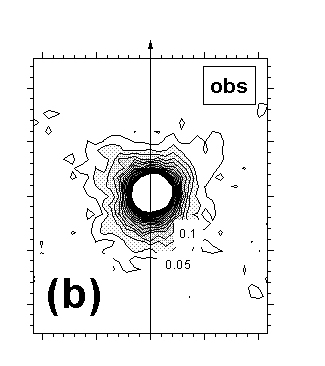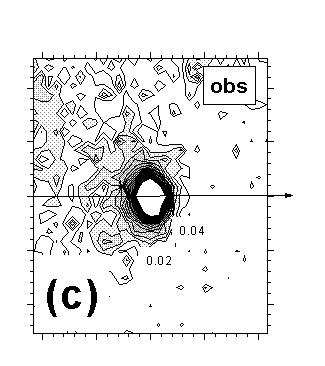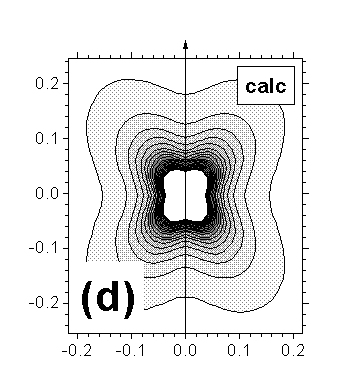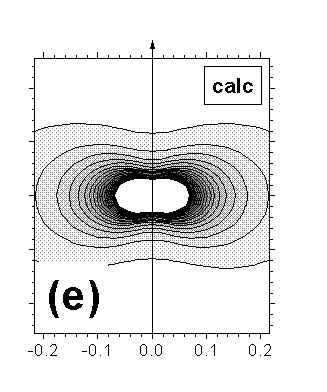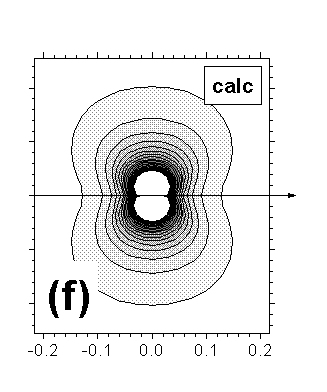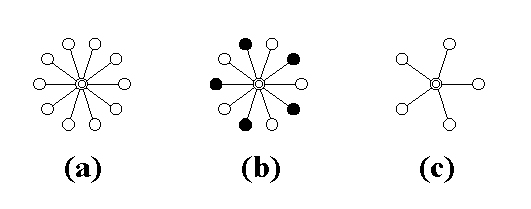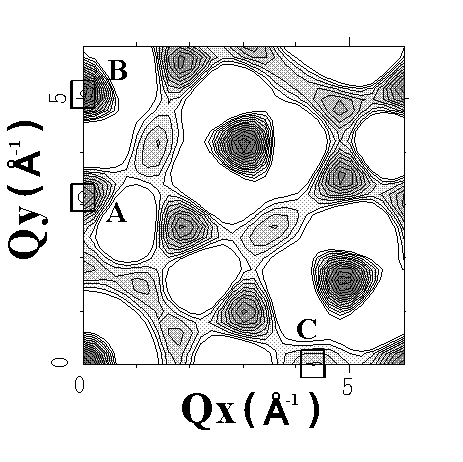Anomalous-X-Ray Scattering Associated with Short-Range Order in an Al70Ni15Co15
Decagonal Quasicrystal
Hiroshi Abea,b,*,
Nobumichi Tamura b, D. Le Bollocfh b,
Simon C. Moss b, Yoshie Matsuo c,
Yasushi Ishii d, Jianming Bai e
a Department of Materials Science and Engineering, National
Defense Academy, Yokosuka 239-8686, Japan
b Department of Physics, University of Houston, Houston,
Texas 77204-5506, USA
c Department of Physics, Nara Women's University, Nara 630-8263,
Japan
d Department of Physics, Chuo University, Tokyo 112-8551,
Japan
e Oak Ridge Associated Universities, Oak Ridge, Tennessee
37831, USA
Mater. Sci. Eng. A 294-296, 299 (2000).
The diffuse scattering around Bragg reflections was observed
in a single decagonal quasicrystal of Al70Ni15Co15
using anomalous-x-ray scattering. The intensities of diffuse scattering
vary with the three incident X-ray wavelengths, near the Co K-edge and
the Ni K-edge and between them. The contrast of diffuse scattering shows
the existence of atomic short-range order (SRO)
between Ni and Co. The distributions of diffuse scattering are anisotropically
modulated and the diffuse shapes vary from one reciprocal lattice point
to another. In quasicrystals, anisotropic diffuse shapes derive from phason
strain. It is concluded that both SRO and
phason strains exist in Al70Ni15Co15.
In addition, as the first neighbor of Ni, Ni is preferred to Co statistically,
since SRO intensities appear about zone-centers,
i.e. there is local clustering of these species.
Keywords: Short-range order, Phason, Anomalous-X-ray
scattering, Decagonal quasicrystal
References
[1] W. Steurer, H. Haibach, B. Zhang, S. Kek, R. Luk, Acta Cryst. B
49 (4) (1993) 661-675.
[2] M A. Chernikov, H. R. Ott, A. Bianchi, A. Migliori, T. W. Darling,
Phys. Rev. Lett. 80 (2) (1998) 321-324.
[3] A. D. Bianchi, F. Bommeli, F. Felder, M. Kenzelmann, M. A. Chernikov,
L. Degiorgi, H. R. Ott, K. Edagawa, Phys. Rev. B 58 (6) (1998) 3046-0356.
[4] K. Hiraga, F. J. Lincoln, W. Sun, Mater. Trans. JIM 32 (4)
(1991) 308-314.
[5] K. Edagawa, H. Sawa, S. Takeuchi, Phil. Mag. Lett. 69 (4)
(1994) 227-234.
[6] K. Hradil, T. Proffen, F. Frey, S. Kek, H. G. Krane, T. Wroblewski,
Phil. Mag. B 71 (5) (1995) 955-966.
[7] A. Baumgarte, J. Schreuer, M. A. Estermann, W. Steurer, Phil. Mag.
A 75 (6) (1997) 1665-1675.
[8] T. C. Lubensky, J. E. S. Socolar, P. J. Steinhardt, P. A. Bancel,
P. A. Heiney, Phys. Rev. Lett. 57 (12) (1986) 1440-1443.
[9] H. Abe, T. Tamura, D. Le Bollocfh, S. C. Moss, Y. Matsuo, Y. Ishii,
J. Bai, submitted to Phys. Rev. Lett.
[10] Ishii, submitted to Mater. Sci. & Eng. A.
[11] Z. M. Stadnik, D. Purdie, M. Garnier, Y. Baer, A. -P. Tsai, A.
Inoue, K. Edagawa, S. Takeuchi, K. H. J. Buschow, Phys Rev. B 55
(16) (1997) 10938-10951.
[12] S. C. Moss, Mater. Res. Soc. Symp. Proc. 376 (1995) 675-687.
 Back
to Publications List
Back
to Publications List
ab@cc.nda.ac.jp
Department of Materials Science and Engineering
National Defense Academy
Last Modified: April 1, 2009
